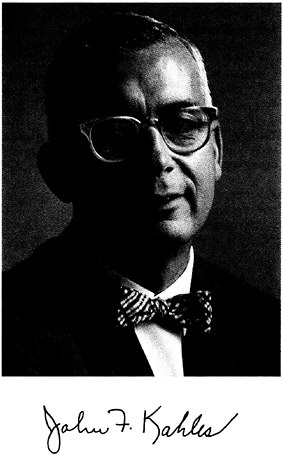JOHN F. KAHLES
1914–1993
BY MICHAEL FIELD
JOHN F. KAHLES, retired senior vice-president of Metcut Research Associates Inc., Cincinnati, Ohio, died May 26, 1993. John Kahles was an educator, a metallurgist, an author, a manufacturing engineer, and an industrialist. He played a major role in providing data and information for the manufacturing industry of the United States and the industrial counties of the world.
John was born in Chicago, Illinois, on September 11, 1914. He received a B.S. in chemical engineering from Armour Institute of Technology (now Illinois Institute of Technology) in 1936. He did his graduate work at the University of Cincinnati, where he received a Ph.D. in metallurgical engineering in 1946. During his years at the University of Cincinnati, he was an instructor, assistant professor, and associate professor of metallurgical engineering. In 1951 John joined Metcut Research Associates as a full partner. Metcut Research had been formed in 1948 and was principally involved in metal cutting and machinability research and testing. John had been retained as a consultant to Metcut from its beginning. His earliest efforts were in failure analysis and use of metallurgy in the analysis of machinability and the metal cutting process. A good deal of John's early work was devoted to failure analysis principally in the aircraft industry.
Starting in the 1950s Metcut Research was involved in developing machinability data for a host of new aircraft and aircraft
engine components. Much of this work was under sponsorship of the U.S. Air Force Manufacturing Technology Division at Wright Field. Additional efforts were under way to investigate the machinability of cast and wrought ferrous alloys for the automotive and transportation industries. John was instrumental in the investigation of the association of metallurgical structures of these alloys to their machinability characteristics. He demonstrated that the microstructure of cast and wrought steels and alloys directly influenced the cutting performance and with it the economics of the machine tool performance.
John recognized the need for a central machinability data center for industry. He set up such a center at Metcut Research, and in 1964 the U.S. Air Force started to fund the "Air Force Machinability Data Center" at Metcut. This center collected and disseminated machining data and associated information to all contractors and subcontractors in the aeronautic industry doing work for the U.S. Air Force. This data center continued in operation under sponsorship of the U.S. Air Force and the Department of Defense until 1980 and then reverted back to Metcut Research through internal funding.
In 1959 the Army Ordnance Corps put out a request for a machining data handbook, which would provide machining data for every machining operation and for every material and alloy capable of being machined. At the time it seemed to be an impossible task, but under John's direction, Metcut developed the Machining Data Handbook, which is now a two-volume set in its third edition and has sold over 70,000 copies. The handbook, of which John was the editor, gives complete machining conditions for over 1,500 metals, alloys, and nonmetallics. It covers eighty machining operations including thirty nontraditional machining processes. One of the major factors making this handbook possible was the classification of the 1,500 work materials into sixty-one categories, each having similar machining characteristics.
An additional accomplishment of John's was the establishment of Metcut's machining seminar entitled Practical Machining Principles for Shop Application. This seminar series was started in 1974. About 240 sessions have been given to date, and 8,800 people from industry and academia have attended.
John was also heavily involved in a study of the relations of surfaces generated in the machining process to the mechanical properties of structural components. In 1964 he and his colleague Michael Field coined the term "surface integrity" and applied it to this subject, which has since been used as a quality standard around the world.
John became vice-president of Metcut in 1958 and senior vice-president from 1978 to his retirement in 1990. He was a prolific author and contributor to metallurgical and manufacturing literature. He wrote about one hundred papers. He also was heavily involved in educational and engineering committees and societies at both the local and the national levels. He was a member of Phi Lamba Epsilon, Tau Beta Pi, Sigma Xi, and Alpha Sigma Mu. He was awarded many honors, including the William Hunt Eisenman Award from the American Society of Metals International, Cincinnati Chapter; the Joseph Whitworth Prize from the Institution of Mechanical Engineers, London, England; fellow, American Society for Metals; Engineer of the Year, Technical and Scientific Societies Council of Cincinnati; Distinguished Alumnus Award, University of Cincinnati; and the Research Medal, Society of Manufacturing Engineers. He was elected to the National Academy of Engineering in 1984.
John Kahles was above all a generous and friendly person. He was a strong family-oriented individual. He and his wife, Bea, had seven children and fourteen grandchildren. His house was always filled with his children and innumerable neighbors and friends. He had a 160-acre retreat in Blind River, Canada, where he and his family had vacationed each summer for thirty-five years.





